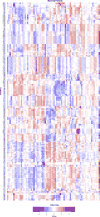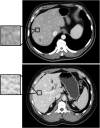Quantitative Imaging Features and Postoperative Hepatic Insufficiency: A Multi-Institutional Expanded Cohort
- PMID: 29454098
- PMCID: PMC5924623
- DOI: 10.1016/j.jamcollsurg.2018.02.001
Quantitative Imaging Features and Postoperative Hepatic Insufficiency: A Multi-Institutional Expanded Cohort
Abstract
Background: Post-hepatectomy liver insufficiency (PHLI) is a significant cause of morbidity and mortality after liver resection. Quantitative imaging analysis using CT scans measures variations in pixel intensity related to perfusion. A preliminary study demonstrated a correlation between quantitative imaging features of the future liver remnant (FLR) parenchyma from preoperative CT scans and PHLI. The objective of this study was to explore the potential application of quantitative imaging analysis in PHLI in an expanded, multi-institutional cohort.
Study design: We retrospectively identified patients from 5 high-volume academic centers who developed PHLI after major hepatectomy, and matched them to control patients without PHLI (by extent of resection, preoperative chemotherapy treatment, age [±5 years], and sex). Quantitative imaging features were extracted from the FLR in the preoperative CT scan, and the most discriminatory features were identified using conditional logistic regression. Percent remnant liver volume (RLV) was defined as follows: (FLR volume)/(total liver volume) × 100. Significant clinical and imaging features were combined in a multivariate analysis using conditional logistic regression.
Results: From 2000 to 2015, 74 patients with PHLI and 74 matched controls were identified. The most common indications for surgery were colorectal liver metastases (53%), hepatocellular carcinoma (37%), and cholangiocarcinoma (9%). Two CT imaging features (FD1_4: image complexity; ACM1_10: spatial distribution of pixel intensity) were strongly associated with PHLI and remained associated with PHLI on multivariate analysis (p = 0.018 and p = 0.023, respectively), independent of clinical variables, including preoperative bilirubin and %RLV.
Conclusions: Quantitative imaging features are independently associated with PHLI and are a promising preoperative risk stratification tool.
Copyright © 2018 American College of Surgeons. Published by Elsevier Inc. All rights reserved.
Figures



References
-
- Cucchetti A, Ercolani G, Cescon M, et al. Recovery from liver failure after hepatectomy for hepatocellular carcinoma in cirrhosis: meaning of the model for end-stage liver disease. Journal of the American College of Surgeons. 2006 Nov;203(5):670–6. - PubMed
-
- Mullen JT, Ribero D, Reddy SK, et al. Hepatic insufficiency and mortality in 1,059 noncirrhotic patients undergoing major hepatectomy. Journal of the American College of Surgeons. 2007 May;204(5):854–62. discussion 62-4. - PubMed
-
- Narita M, Oussoultzoglou E, Fuchshuber P, et al. What is a safe future liver remnant size in patients undergoing major hepatectomy for colorectal liver metastases and treated by intensive preoperative chemotherapy? Annals of surgical oncology. 2012 Aug;19(8):2526–38. - PubMed
-
- Kim SH, Kang DR, Lee JG, et al. Early predictor of mortality due to irreversible posthepatectomy liver failure in patients with hepatocellular carcinoma. World journal of surgery. 2013 May;37(5):1028–33. - PubMed
Publication types
MeSH terms
Grants and funding
LinkOut - more resources
Full Text Sources
Other Literature Sources
Medical

